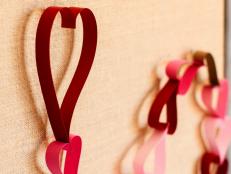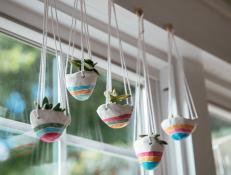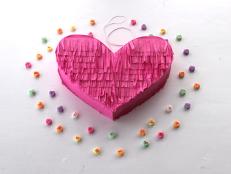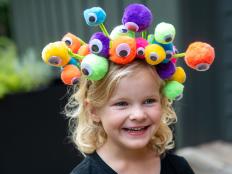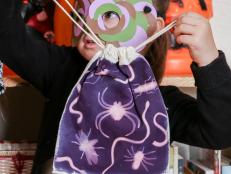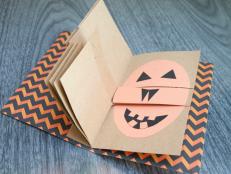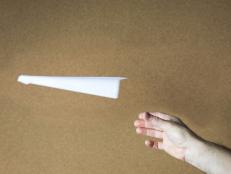DIY Musical Instruments for Kids and At-Home Concert Ideas
Get imaginative with rhythm and sound and create homemade instruments with your kids.

Get creative this summer by building your own garage band of homemade instruments with items you may already have around the house. Foster your child’s appreciation for how instruments work and how different materials make different sounds. Start by helping the kids learn songs with simple rhythms and notes, and then let them choose a few favorites songs too. Or try outfitting your child with as many of the gadgets as you can, modeling a marvelous one-man band!
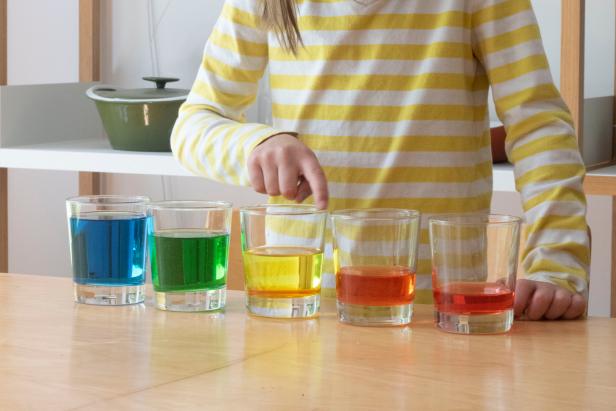
Emily Fazio
Invite friends to make some instruments too. So, when you’re ready to “get the band back together” you can assemble and perform together, garage-band style or via a virtual hangout.
And before you assume that assembling an at-home orchestra with your school-age kids equals extra ibuprofen, take another look at the materials list. We’re intentionally not listing the obvious stainless steel kitchen pot drums and coordinating lid cymbals, but rather opting for soothing alternatives that are still fun and creative and full of possibility, without the sounds of regret.
Materials to get you started:
- PVC pipe
- dowels
- scrap wood
- paper plates
- sensory materials like loose beads, beans, rice, or dry pasta
- cardboard tubes (from toilet paper, paper towels or wrapping paper)
- cardboard boxes
- bobby pins
- wax paper
- bells
- assorted string
- clay
- stapler
- hole punch
- tape
Musical Glasses/Glass Harp
Fill glasses with varied volumes of water, and a drop of food coloring for extra appeal. Help your child understand how rotating their finger along the rim of the glass creates friction and also generates music. Avoid precious stemware for this one and experiment with stable barware instead.
PVC Pipe Xylophone
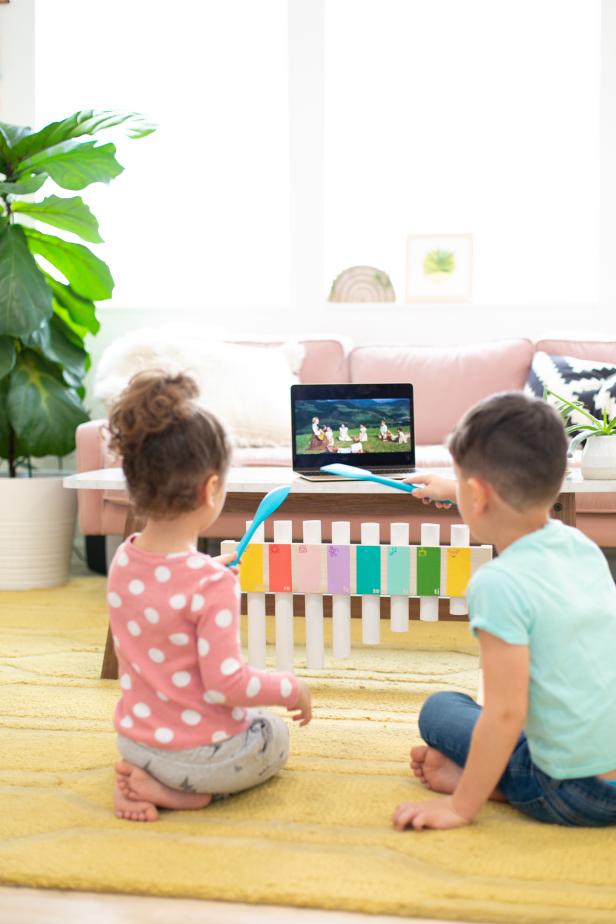
Chelsea Foy of Lovely Indeed, in Partnership with The Rodgers & Hammerstein Organization
Use lengths of PVC pipe, a simple wood structure and colorful paint to create your own xylophone. Activated with soft paddles, such as rubber spatulas or inexpensive rubber flip flops, your kids can drum up their own musical sounds, learn the musical scale, and even learn to follow the notes of simple songs. "Twinkle Twinkle" never sounded so cute as when played on a homemade xylophone. You can get a tutorial for this project and many others at The Sound of Music Crafting Corner.
Didgeridoo
Use the longest cardboard wrapping paper roll you have to demonstrate a DIY didgeridoo. There’s really nothing involved with this from a DIY standpoint, but be sure to share with them a video of a real didgeridoo so they can understand and appreciate the real instrument and the sounds it creates. Encourage your child to try noise-making in different ways into the end of the instrument to demonstrate how the sound waves bounce in the tube. Sing, whisper or shout, but have them blow raspberries for the most enjoyable effect.
Kazoo
Use your shorter cardboard tubes, such as those from toilet paper or a paper towel roll, to create your own kazoo. You’ll need to create a hole in the cardboard tube to allow airflow, so first use a hole punch or a pair of sharp scissors to make that opening. Then, use a rubber band to secure a piece of wax paper around one end of the tube, and hum/blow into the open end to produce the classic kazoo sound that you all know and love.
Noise Sticks
Scrap wood and dowels come in handy when you’re looking to drum up your own percussion section (so punny). Use a handsaw to cut notches into dowels. When kids tap and drag the notched dowels together, they’re on their way to having their own percussion section.
Wooden Block or Wooden Guiro
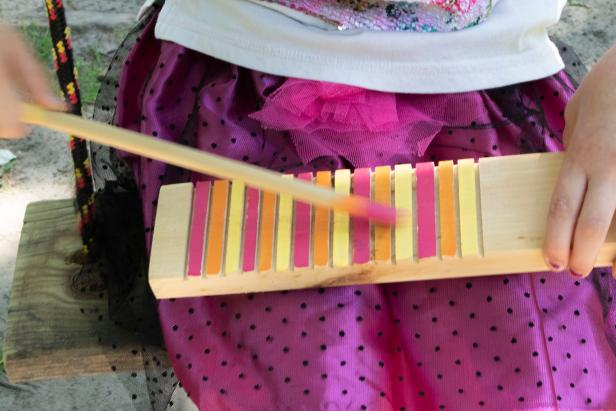
Emily Fazio
Use a table saw or chop saw to create dados in a piece of scrap wood. Sand it down, and let your kids paint it up! Use a dowel to activate the wood block which, obviously, can be tapped rhythmically like any drum, or strummed to simulate the effect of a wooden guiro.
Paper Plate Hand Drums or Tambourine
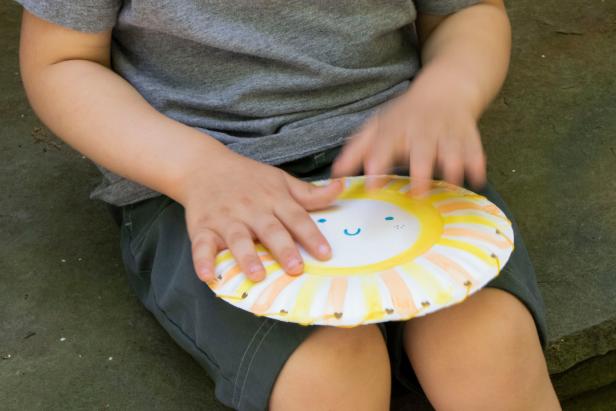
Emily Fazio
Use a hole punch and thread to attach two paper plates to create a hollow, paper drum. Kids can carry and tap with their hands or any found object that they liken to a drumstick, such as a branch from the yard or ordinary pencils. Find that rhythm, little man!
The best part about this simple paper plate instrument is its versatility – add bells around the end to turn it into a tambourine, dry beans or other sensory objects between the plates to transform it into a soothing shake instrument, or attach wooden beads on strings and a handle to turn it into a spin drum.
Pan Flute
A fun lesson in wind instrument functionality for kids of all ages, you can make your own pan flute using not much more than a few straws. If you happen to have a collection of wide bubble tea straws, you’re in luck, but ordinary paper and plastic straws will work well too. Trim the straws to different lengths, fill one end of each straw with air dry clay (or cover it with tape), and organize them shortest to longest so that the open end of each straw is evenly lined up. Use a piece of tape across the center to hold them together, and attach a string so that the instrument can easily hang around your child’s neck. Blow gently across the ends of the straws to play, and experiment with the flute-like sounds that emit from the instrument.
Cardboard Box Guitar
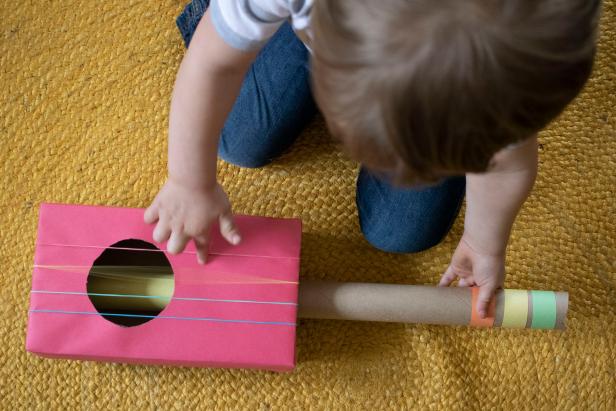
Emily Fazio
With an empty tissue box, a paper towel tube and several rubber bands, you can easily create your own toddler-friendly guitar. Use rubber bands of different thicknesses to produce different sounds, and allow your child to strum-strum-strum.






